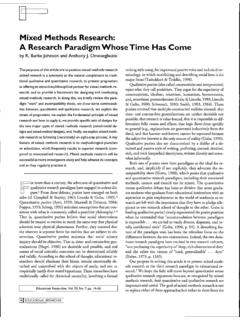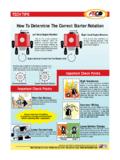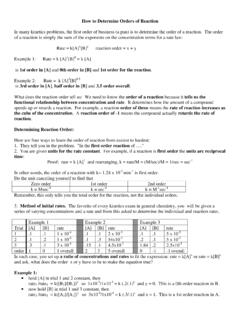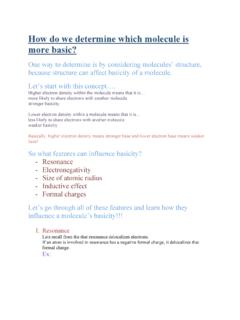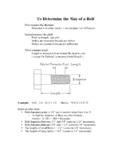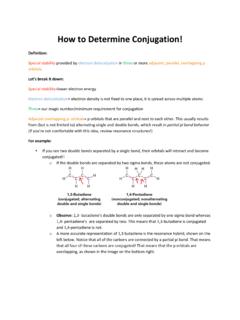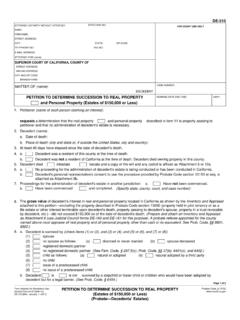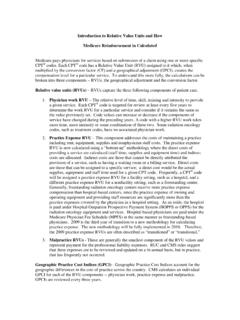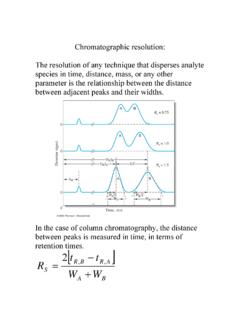Transcription of CHEM 51LC - EXPERIMENT 5 DETERMINING ABSOLUTE ...
1 CHEM 51LC - EXPERIMENT 5 DETERMINING ABSOLUTE CONFIGURATION OF SECONDARY ALCOHOLS USING THIN-LAYER CHROMATOGRAPHY (TLC) AND YOUR SMARTPHONE During this EXPERIMENT , you will determine the ABSOLUTE configuration of an unknown chiral secondary alcohol using the competing enantioselective conversion (CEC) method. The CEC method was developed here at UC Irvine. This method uses a chiral acyl-transfer catalyst called homobenzotetramisole (HBTM) and a common technique used in organic laboratories: thin-layer chromatography (TLC). You will photograph your TLC plate (with a smart phone or any other photo-taking device) and perform a quantitative analysis using a program called ImageJ. You will also determine the molecular structure of the unknown alcohol you have using 1H NMR spectroscopy. REACTIONS: Esterification of a secondary alcohol using a chiral acyl-transfer catalyst TECHNIQUES: Thin-Layer Chromatography, ImageJ Analysis READING ASSIGNMENT Technique : Measuring Volume and Transferring Liquids in Techniques in Organic Chemistry 3rd Ed.
2 Pgs 42 47. Review Technique 17: Thin-Layer Chromatography in Techniques in Organic Chemistry 3rd Ed. pgs 221 235. J. Org. Chem. 2013, ASAP. ( ) The Importance of Chirality and ABSOLUTE Configuration: Understanding Molecular Reactions in 3-D (included in Background) Interaction of R-1-phenylethanol with Activated S-HBTM Intermediate (included in Background) Working with ImageJ Handout (attached) PRE-LAB ASSIGNMENT Complete all portions of the pre-lab notebook work according to the guidelines. o In your lab notebook, as part of your purpose section, write a paragraph describing the method used in the Journal of Organic Chemistry paper. Explain the rationale for DETERMINING ABSOLUTE configuration and how that applies to this laboratory EXPERIMENT . o For your reagent table, include the information for all possible alcohols. Additionally, HBTM is a solid with a molar mass of g/mol.
3 Rewrite the procedure from Part I of this EXPERIMENT . When rewriting the procedure, pay close attention to detail. You do not need to rewrite instructions from Part II on how to use ImageJ. Draw a Flowchart of Part I, including all additions to each of your reactions. Complete the Sapling assignment BACKGROUND The Importance of Chirality and ABSOLUTE Configuration: Understanding Molecular Reactions in 3-D As you previously learned in organic lecture, molecules are not the flat, two-dimensional pictures that we draw on paper, but are actually three-dimensional structures. This reality leads to a concept called chirality , with which you should already be familiar. A chiral center has two stereoisomers that are enantiomers, or mirror images, of one another. Enantiomers can have differences as minor as dissimilar odors, as in the case of carvone, or as major as having different biological effects, such as thalidomide (shown below).
4 For those of you with a particular interest in biology, the concept of chirality is equally important when we consider biological processes carried out by enzymes. Remember that enzymes are complex three-dimensional structures, which is why they are incredibly efficient and role-specific. In the same way that only certain keys can be used to unlock a door, only certain compounds can be accepted by an enzyme. For drug development, isolation of natural products, and for enzyme recognition in particular, chemists today realize the importance of being able to identify the ABSOLUTE configuration of chiral centers in compounds. There are methods to determine the ABSOLUTE configuration of stereocenters in a given molecule that contain a certain type of functional group. This week, you will be using the competing enantioselective conversion (CEC) method to determine the ABSOLUTE configuration of a chiral secondary alcohol.
5 This EXPERIMENT is adapted from a published method in the scientific literature that was developed at UC Irvine (J. Org. Chem. 2013 ASAP). Alcohols are one of the most common functional groups found in isolated natural products. When using the CEC method to determine ABSOLUTE configuration, a single enantiomer of a secondary alcohol is used in parallel reactions with each enantiomer of HBTM. The overall reaction is an esterification of the secondary alcohol that proceeds via an activated intermediate of the catalyst (shown below using S-HBTM). Additional reagents in the reaction are propionic anhydride and an amine base (we will be using triethylamine). NSNPhOOONSNPhOR1R2 OHNEt3R1R2 OOS-HBTMHNHNOOOONHHNOOO(R)-ThalidomideSe dative Effects(S)-ThalidomideImmunological EffectsTeratogenic (>20,000 victims)O When using the CEC method, the secondary alcohol will react faster with one enantiomer of the HBTM catalyst (the matched or fast case) than with the other HBTM enantiomer (the mismatched or slow case).
6 After an EXPERIMENT confirms which of the parallel reactions is progressing faster, that information is compared to a mnemonic (shown below) that identifies the ABSOLUTE configuration of the secondary alcohol. You will be using TLC to discover which enantiomer of HBTM reacts fastest. A quantitative analysis will also be carried out using a free program called ImageJ. The program ImageJ is most commonly used by biochemists to determine quantities of biological compounds in gels. As you read the Journal of Organic Chemistry paper and the procedure for this EXPERIMENT , you should think about the mechanism of the reaction and why this mechanism leads to the difference in reaction rate between the two HBTM enantiomers. In particular, think about the difference in the 3-D environment during each set of reaction conditions. Understanding this will be critical to writing a coherent lab discussion.
7 Important questions to consider: What is the difference between the two enantiomers of HBTM? Why might that difference have an effect on the reaction rate? CH3 HOH(S)-HBTM faster(R) (R) ConfigurationXCH3 HOH(S) ConfigurationXInteraction of R-1-phenylethanol with the Activated S-HBTM Intermediate Spartan 3-D Image Molecular Structure The pictures above show the interaction of the R enantiomer of a representative secondary alcohol with the S-HBTM catalyst. A few factors are hypothesized to dictate this interaction. First, notice the red phenyl ring in the molecular structure on the S-HBTM catalyst. This ring serves to block the alcohol from interacting with the catalyst from the bottom face, as drawn. The result of blocking one face is called a steric effect. Therefore, the alcohol should interact with the catalyst from the top face.
8 Second, notice the blue aromatic systems highlighted on both the catalyst and the alcohol in the molecular structure. These aromatic systems are participating in pi-stacking. This effect brings the alcohol and the catalyst together, much like what we see in the base pairs of our DNA! Finally, notice the position of the alcohol in proximity to the carbonyl of the catalyst intermediate (highlighted with a dashed line in the molecular structure). The R enantiomer of the alcohol will have the alcohol facing directly over the carbonyl of the activated catalyst, providing an easy path for the R-alcohol to attack the carbonyl. If we were to consider the S enantiomer of the alcohol attempting to react with S-HBTM in the same way, the alcohol OH group will be positioned farther away from the carbonyl of the activated catalyst and will therefore not be able to reach the carbonyl as easily.
9 Therefore, the R enantiomer of the alcohol will be the fast reaction with S-HBTM and the S enantiomer of the alcohol will be the slow reaction with S-HBTM. SNNOHOCH3 HHstericsPi-stackingR-1-phenylethanol S-HBTM EXPERIMENTAL Part I: Reaction Set-up and TLC (work in pairs) A solution of one enantiomer of an unknown secondary alcohol has been prepared for you. The ABSOLUTE configuration (which enantiomer you have) of the alcohol is also unknown. The unknown alcohol is one of the following three compounds: Your unknown will be the R- or the S- enantiomer of one of these compounds. Your goals are to: 1) determine which unknown alcohol you have using the 1H NMR spectra given to you. 2) determine which enantiomer of the unknown alcohol you have using the competing enantioselective conversion (CEC) method described in the Journal of Organic Chemistry paper and in the background of this handout.
10 Your unknown secondary alcohol will be provided to you as a solution in toluene ( M). Write the unknown number of this solution in your lab notebook and on the table included at the end of this handout. In the following procedure, this unknown solution will be referred to as Solution 1. Three stock solutions have been prepared for you: Stock Solution Compounds in Solution Solution 2 S-HBTM ( M) and Et3N ( M) in toluene Solution 3 R-HBTM ( M) and Et3N ( M) in toluene Solution 4 Propionic anhydride ( M) in toluene IMPORTANT SAFETY INFORMATION Hexanes, ethyl acetate, and toluene are volatile organic solvents. They are also flammable. Use them in the hood and wear gloves when working with them! Phosphomolybdic acid is a stain used with thin-layer chromatography. It is a skin irritant! Gloves should be worn when working with it. The major component of the stain is ethanol, which is also flammable.



